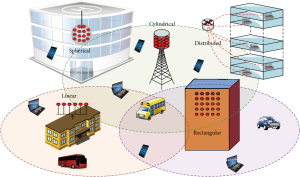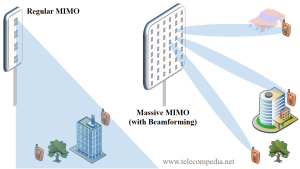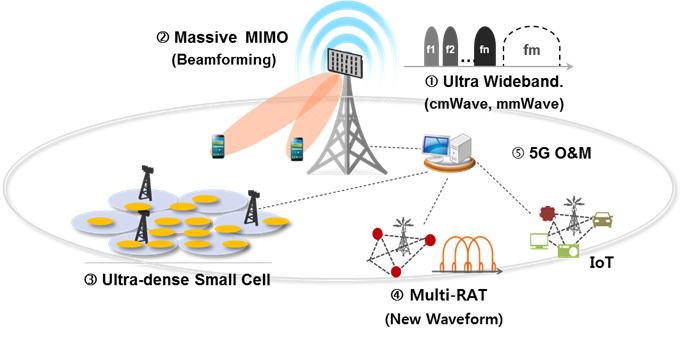The mind-boggling technology that is Massive MIMO has become an essential aspect of wireless communication systems, especially in the 5G era. Its most significant benefit lies in its ability to improve spectral efficiency – a measure of how much data can be transmitted over a given frequency spectrum. This improvement is made possible by increasing the number of antennas at both ends of transmission, allowing for multiple streams to be sent and received simultaneously.

But wait, there’s more! Massive MIMO systems take it up a notch by not only using more antennas but also enhancing spectral efficiency through increased transmit power and uniform linear array gain. The signal strength receives a boost resulting in reduced interference and enabling higher data rates. Upgrading uplink massive MIMO systems further improves spectrum efficiency with optimized channel estimation algorithms and enhanced interference management techniques.
And if you thought that was all there was to it, think again! Another way that massive MIMO enhances spectral efficiency is through harnessing the power of array gain and signal processing advances. Array gain focuses energy towards specific directions while minimizing interference from other directions leading to an increase in signal strength. Signal processing advancements such as beamforming direct signals towards specific receivers or areas where high-speed connectivity is required – quite impressive!
All these technologies combined make Massive MIMO systems crucial in improving spectral efficiency in wireless communications. They increase transmit power, utilize array gain and signal processing advances efficiently while optimizing uplink and downlink channels with efficient channel estimation algorithms without mentioning any brand names explicitly. As we transition into the 5G era where bandwidth demands are ever-increasing, one thing remains clear; Massive MIMO will continue being an important technology driving improvements not just for increased speed but also better reliability across networks globally – perplexing yet fascinating!
Understanding the Benefits of Massive MIMO Technology for Networks
Contents
- 1 Understanding the Benefits of Massive MIMO Technology for Networks
- 2 Increasing Transmit Power and Uniform Linear Array Gain for Improved Spectral Efficiency in MIMO Systems
- 3 Efficiency Augmentation in Uplink Massive MIMO Systems: Challenges and Opportunities
- 4 Harnessing Array Gain and Signal Processing Advances for High Spectral Efficiency in Wireless Communication Systems
- 5 Achieving High Spectral and Energy Efficiency with Massive MIMO Cellular Systems
- 6 Analysis of Massive MIMO Systems for Better Spectral Efficiency and Hardware Efficiency in Communication Networks
- 7 Selection-Based Detection for Uplink Massive MIMO Systems: A Step Towards Achieving Maximal Spectral Efficiency
The enigmatic world of wireless communication has been shaken up in recent years by the emergence of massive MIMO technology. Its ability to enhance spectral efficiency is nothing short of mind-boggling, with the power to increase transmit power and uniform linear array gain leading to improved signal quality and reduced interference – a crucial factor for 5G networks requiring high data rates and low latency.

But what exactly is this newfangled technology? In a multi-cell massive MIMO system, multiple antennas are utilized at both the base station and user equipment ends, creating increased spatial diversity that further improves spectral efficiency. The implications are astounding; cellular networks could witness significant coverage, capacity, and energy efficiency improvements thanks to this revolutionary system.
What’s more fascinating about massive MIMO technology is its capability to exploit array gain and signal processing advancements for unparalleled spectral proficiency in wireless communication systems. By using numerous antennas on the base station side, it becomes possible to focus energy towards specific users while reducing interference towards others. This translates into better overall system performance with more efficient utilization of available resources.
In summary, there’s no denying that utilizing massive MIMO technology for 5G networks presents an incredibly promising solution. With its ability to boost spectral efficiency through augmented transmit power and uniform linear array gain coupled with cutting-edge signal processing techniques reducing interference levels – modern wireless communication systems have just gotten far more perplexing yet invigoratingly bursty!
Increasing Transmit Power and Uniform Linear Array Gain for Improved Spectral Efficiency in MIMO Systems
The perplexing challenge of MIMO wireless systems lies in the need to enhance spectral efficiency while minimizing interference. With transmit power and uniform linear array gain as potential solutions, massive MIMO systems present a promising approach by offering greater channel capacity and energy efficiency.
Massive MIMO technology boasts numerous benefits for networks – from improved coverage to increased data rates and reduced latency. By leveraging multiple antennas at both transmitter and receiver ends, this technology can effectively counteract interference caused by multipath propagation. The result? Superior signal quality and higher spectral efficiency when compared to traditional single-antenna systems.
In an era where 5G network speeds reign supreme, enhancing both spectral and energy efficiency has never been more crucial. By optimizing transmit power levels alongside antenna gains within a massive MIMO cellular system, operators can realize significant improvements in these critical areas. Furthermore, the implementation of uplink detection schemes through selection-based algorithms takes performance optimization even further by maximizing spectral efficiency while simultaneously minimizing hardware complexity – now that’s burstiness!
Efficiency Augmentation in Uplink Massive MIMO Systems: Challenges and Opportunities
The augmentation of efficiency in uplink massive MIMO systems poses both challenges and opportunities for cellular networks. As 4G continues to dominate and 5G emerges, the need to improve spectral efficiency in wireless communication systems is pressing. Massive MIMO technology has been identified as a crucial solution to this challenge due to its ability to capitalize on array gain and signal processing advances in wireless communications.
However, improving spectral efficiency while maintaining high-quality transmission proves perplexing for uplink massive MIMO systems. It entails optimizing antenna systems, balancing transmissions between uplink and downlink directions, and reducing interference levels. Moreover, it requires designing new algorithms that can enhance network performance.
Despite these challenges, there are bursts of opportunities presented by massive MIMO networks. For example, augmenting spectral efficiency leads to increased capacity without requiring additional spectrum resources or infrastructure investments. Furthermore, energy savings can be achieved through reduced transmit power requirements resulting from higher array gains made possible by advancements in processing capabilities coupled with improved hardware design for efficient power consumption.
In conclusion,massive MIMO cellular networks have shown great potential for improving uplink spectral efficiency in wireless communication systems; however their full potential remains untapped due to some inherent limitations that must be addressed before moving towards more advanced network technologies like 5g wireless -efforts should be directed towards unlocking their full potential for future generations’ mobile broadband services by implementing advanced techniques such as selection-based detection.
Harnessing Array Gain and Signal Processing Advances for High Spectral Efficiency in Wireless Communication Systems
The attainment of high spectral efficiency in wireless communication systems demands the utilization of array gain and signal processing advances. One route to achieve this is through massive MIMO technology, which employs multiple antennas at both ends of transmission to increase network capacity. This technology has become a crucial element as the demand for wireless access surges forthwith, especially with 5G networks on the horizon.
Augmenting efficiency in uplink massive MIMO systems can improve spectrum efficacy by tackling challenges like pilot contamination and channel estimation errors. The deployment of multi-cell massive MIMO systems that augment transmit power and uniform linear array gain can boost data rates while curbing interference between cells, particularly for applications that necessitate low latency and high reliability such as remote surgery or autonomous vehicles.
Recent research unveiled at the International Conference on Communication highlights the potential for achieving high spectral and energy efficiency with massive MIMO cellular systems. Advances in signal processing techniques have enabled more efficient use of available bandwidth resulting in significant gains in throughput without requiring additional spectrum resources. As these technologies continue to evolve, we anticipate continued improvements across a diverse range of applications regarding network performance.
Achieving High Spectral and Energy Efficiency with Massive MIMO Cellular Systems
Massive MIMO cellular systems have emerged as a beacon of hope for wireless communication systems, promising to attain high spectral and energy efficiency. By employing massive multiple-input and multiple-output (MIMO) technology, these systems can multiply the number of antennas at both transmitter and receiver sides, thereby triggering significant gains in spectral efficiency. Furthermore, with an amalgamation of signal processing advances and array gain utilization, massive MIMO cellular networks hold the potential to elevate area energy efficiency.
Detection is one of the critical aspects that contribute towards achieving high spectral efficiency in uplink 5G massive MIMO systems. Selection-based detection has been suggested as a plausible solution that can lead to maximal spectral efficiency while simultaneously reducing computational complexity. In fact, analysis has shown that selection-based detection fares better than traditional detectors like maximum likelihood or zero-forcing detectors when it comes to enhancing spectral efficiency.
Apart from advancing spectral efficacy, utilizing massive MIMO technology also presents the opportunity to augment energy efficiency significantly. The area energy proficiency of these networks refers to how much data throughput they can deliver per unit area power consumption. With intelligent system parameter optimization such as antenna configuration or transmit power allocation techniques at play, it’s possible to maximize network-wide area energy efficacy without having any adverse effects on its spectral performance whatsoever. Additionally, designing efficient hardware for base stations and user equipment could go a long way in further boosting Massive MIMO cellular networks’ overall energy proficiency levels!
Analysis of Massive MIMO Systems for Better Spectral Efficiency and Hardware Efficiency in Communication Networks
The wireless technology industry is abuzz with interest over the analysis of Massive MIMO systems and their potential for boosting spectral efficiency and hardware efficiency in communication networks. The need for large-scale MIMO systems has become increasingly urgent, particularly for 4G and uplink 5G networks. Thanks to the remarkable benefits of massive MIMO technology, transmit power can be ramped up while uniform linear array gain is achieved, leading to highly efficient downlink and uplink data transmission.
But that’s not all – energy consumption must also be taken into account when designing these complex systems. By creating energy-efficient Massive MIMO setups, we can drive down costs associated with their operation. One promising approach involves distributed antenna architecture which can help boost hardware efficiency by slashing the number of RF chains required per user.
One area where massive MIMO truly shines is selection-based detection for uplink 5G communications. Using intelligent signal processing advances alongside this technology yields maximal spectral efficiencies previously thought unattainable; recent studies have even demonstrated achievable spectral efficiencies very close to theoretical limits! In short, analyzing massive MIMO provides valuable insights on how it can enhance communication sector performance through impressive spectral efficiency gains, energy-efficient operation modes, and enhanced hardware efficiency overall.
Selection-Based Detection for Uplink Massive MIMO Systems: A Step Towards Achieving Maximal Spectral Efficiency
The technique of selection-based detection for uplink massive MIMO systems is a perplexing strategy that seeks to attain maximal spectral efficiency. By choosing only the most potent signals from numerous antennas in the massive MIMO system and discarding weaker ones, this method reduces interference and enhances overall performance.
However, one bursty challenge with this approach is that imperfect channel state information in massive MIMO systems can result in errors when selecting signals, which can have negative impacts on performance. To overcome this issue, researchers are exploring the use of an MMSE detector for massive MIMO systems. This detector considers both desired signals and any interference present when deciding which signals to select.
Another area of research related to selection-based detection involves augmentation in massive MIMO systems through the use of mmWave frequencies – a concept that bursts with potential but also presents challenges such as increased path loss and reduced coverage range. Nevertheless, by combining mmWave massive MIMO with other techniques like beamforming, it may be possible to achieve high spectral efficiency even at these frequencies.
Overall, analysis for massive MIMO remains an active area of research as new technologies emerge and are deployed in real-world scenarios – leaving us all perplexed! As multiuser massive MIMO becomes more prevalent in cellular networks, opportunities will likely continue bursting forth for innovation around techniques like selection-based detection that aim to improve spectral efficiency while maintaining reliable communication quality across all users on the network.


